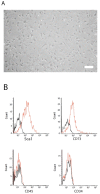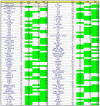Effect of Different Preconditioning Regimens on the Expression Profile of Murine Adipose-Derived Stromal/Stem Cells
- PMID: 29890767
- PMCID: PMC6032282
- DOI: 10.3390/ijms19061719
Effect of Different Preconditioning Regimens on the Expression Profile of Murine Adipose-Derived Stromal/Stem Cells
Abstract
Stem cell-based therapies require cells with a maximum regenerative capacity in order to support regeneration after tissue injury and organ failure. Optimization of this regenerative potential of mesenchymal stromal/stem cells (MSC) or their conditioned medium by in vitro preconditioning regimens are considered to be a promising strategy to improve the release of regenerative factors. In the present study, MSC were isolated from inguinal adipose tissue (mASC) from C57BL/6 mice, cultured, and characterized. Then, mASC were either preconditioned by incubation in a hypoxic environment (0.5% O₂), or in normoxia in the presence of murine epidermal growth factor (EGF) or tumor necrosis factor α (TNFα) for 48 h. Protein expression was measured by a commercially available array. Selected factors were verified by PCR analysis. The expression of 83 out of 308 proteins (26.9%) assayed was found to be increased after preconditioning with TNFα, whereas the expression of 61 (19.8%) and 70 (22.7%) proteins was increased after incubation with EGF or in hypoxia, respectively. Furthermore, we showed the proliferation-promoting effects of the preconditioned culture supernatants on injured epithelial cells in vitro. Our findings indicate that each preconditioning regimen tested induced an individual expression profile with a wide variety of factors, including several growth factors and cytokines, and therefore may enhance the regenerative potential of mASC for cell-based therapies.
Keywords: cytokines; mesenchymal stromal/stem cells; preconditioning; pretreatment; regeneration; secretion; stem cells.
Conflict of interest statement
The authors declare no conflict of interest.
Figures





References
-
- Hsiao S.T.-F., Asgari A., Lokmic Z., Sinclair R., Dusting G.J., Lim S.Y., Dilley R.J. Comparative Analysis of Paracrine Factor Expression in Human Adult Mesenchymal Stem Cells Derived from Bone Marrow, Adipose, and Dermal Tissue. Stem Cells Dev. 2012;21:2189–2203. doi: 10.1089/scd.2011.0674. - DOI - PMC - PubMed
MeSH terms
Substances
LinkOut - more resources
Full Text Sources
Other Literature Sources

